Suntan Hybrid Tantalum Capacitor– TS25-07
Suntan Technology Company Limited

Suntan Technology Company Limited

Suntan Technology Company Limited
--All Kinds of Capacitors
Suntan offer various kinds of Hybrid Tantalum Capacitors, pls check below list for the TS25 series items and datasheet for reference.
If any requirement, welcome to send inquiry to our sales team at info@suntan.com.hk or sales@suntan.com.hk for price checking!
| Suntan Item Description | Series List & Datasheet | ||
| Hybrid Tantalum Capacitors Radial-lead, Heteropolarity | |||
| Hybrid Tantalum Capacitors Radial-lead, Heteropolarity, screws | |||
| Hybrid Tantalum Capacitors Radial-lead, Heteropolarity, 3 screws | |||
| Hybrid Tantalum Capacitors Square, Heteropolarity | |||
| Hybrid Tantalum Capacitors (With Mounting flange) | |||
| Combined Non-solid Electrolytic Tantalum Capacitors | |||
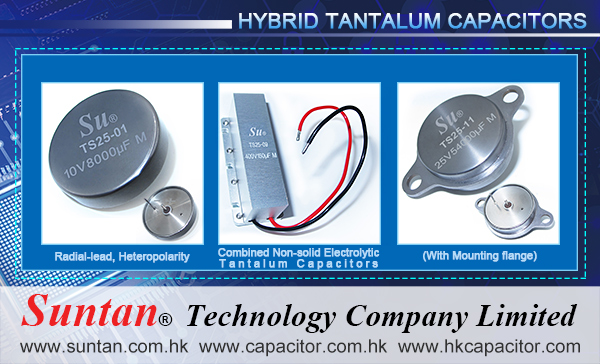
|
| TS19 | TS20 | TS20L |
| Operating temp. | -55°C to +125°C | -55 ~ +125°C | -55°C~+125°C |
| Capacitance range | 0.047uF ~ 680uF | 0.1uF~330uF | 0.47uF~1000uF |
| Capacitance tolerance | ±20%; ±10%; ±5% | ±20%; ±10% | ±20%; ±10% |
Would like to know more details/information? Contact us NOW at sales@suntan.com.hk / info@suntan.com.hk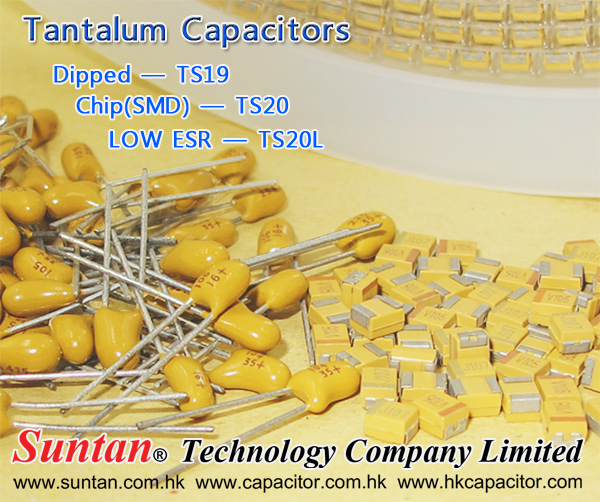
Suntan Technology Company Limited
--All kinds of Capacitors
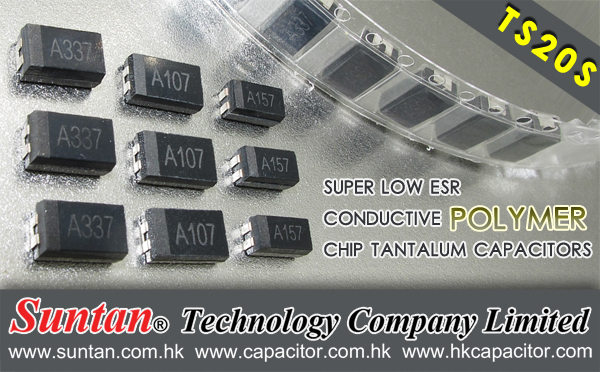
Suntan Technology Company Limited
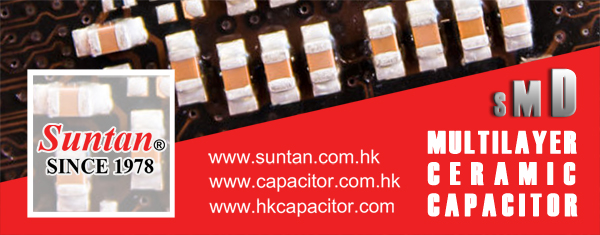
Suntan Technology Company Limited
--All kinds of Capacitors
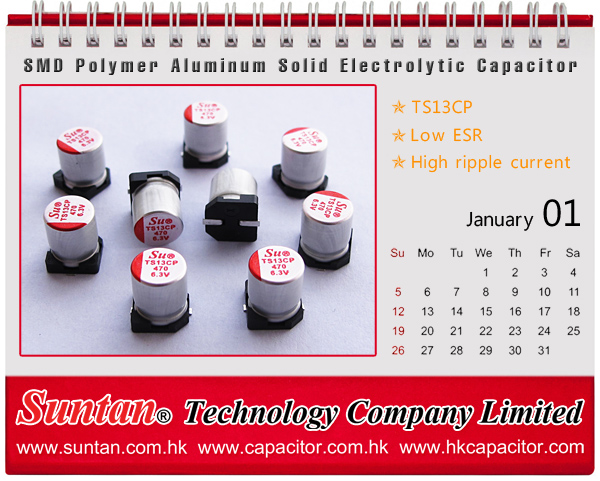
Suntan Technology Company Limited
---All kinds of Capacitors
A capacitor's storage potential, or capacitance, is measured in units called farads. A 1-farad capacitor can store one coulomb (coo-lomb) of charge at 1 volt. A coulomb is 6.25e18 (6.25 * 10^18, or 6.25 billion billion) electrons. One amp represents a rate of electron flow of 1 coulomb of electrons per second, so a 1-farad capacitor can hold 1 amp-second of electrons at 1 volt.
A 1-farad capacitor would typically be pretty big. It might be as big as a can of tuna or a 1-liter soda bottle, depending on the voltage it can handle. For this reason, capacitors are typically measured in microfarads (millionths of a farad).
To get some perspective on how big a farad is, think about this:
If it takes something the size of a can of tuna to hold a farad, then 10,080 farads is going to take up a LOT more space than a single AA battery! Obviously, it's impractical to use capacitors to store any significant amount of power unless you do it at a high voltage.
Applications
The difference between a capacitor and a battery is that a capacitor can dump its entire charge in a tiny fraction of a second, where a battery would take minutes to completely discharge. That's why the electronic flash on a camera uses a capacitor -- the battery charges up the flash's capacitor over several seconds, and then the capacitor dumps the full charge into the flash tube almost instantly. This can make a large, charged capacitor extremely dangerous -- flash units and TVs have warnings about opening them up for this reason. They contain big capacitors that can, potentially, kill you with the charge they contain.
Capacitors are used in several different ways in electronic circuits:
In the next section, we'll look at the history of the capacitor and how some of the most brilliant minds contributed to its progress.

Storage—there is never enough of it. I still remember when I thought my 700MB hard drive was huge... until I tried to copy an entire CD onto it for faster access. After that, I spent a period stuck choosing music to stick on my three GB hard drive. Two weeks ago, I ditched six months' worth of simulation data because my 320GB hard drive was full. One TB of new drive later, and I'm wondering how soon it will be before I start feeling the squeeze again. Maybe never, if some of the latest research coming out of Korea and Germany bears fruit.
One of the cool things about hard drive technology is how it has actually kept pace with computer needs. The basic mechanism for hard drive storage, however, does have some fundamental limitations, which manufacturers will have to deal with fairly soon. Bits are currently stored in the orientation of tiny magnets, called ferromagnetic domains, on a hard drive platter. The smaller the domain, the easier it is for that orientation to be scrambled by temperature or stray electromagnetic fields. At a certain size, thermal photons (e.g., heat energy from the surrounding case or the underlying disk) have enough energy to flip a domain's orientation. Manufacturers will have to keep their domain sizes significantly bigger than that threshold size to ensure data integrity, which puts a ceiling on storage density, one we're rapidly approaching.
An alternative is to use ferroelectric domains. Unlike ferromagnetic domains, ferroelectric domains have a natural electric field with an orientation that can be used to represent data. Until recently, these haven't looked that attractive because they have pretty much the same limitations that ferromagnetic domains have, but they lack the cool read-out tricks. Ferroelectric materials, however, do have one big advantage over ferromagnetic materials: they can be used to make really good capacitors. This is exactly what the latest research, published in Nature Nanotechnology, is about.